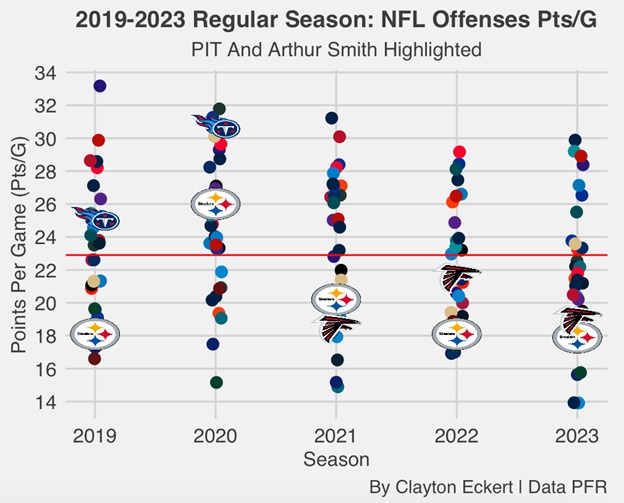A common issue in recent seasons for the Pittsburgh Steelers’ offense has been a painful one: the all-important scoreboard. Surely you heard that discussion, with multiple 2023 coached simply stating, we’ve gotta score more points. While there are several factors that go into it, today’s goal is to look at the Steelers and new offensive coordinator Arthur Smith as a play caller (since 2019), and how they’ve stacked up across the NFL.
Here is the points per game (ppg) visual:
As we can see, Pittsburgh has largely been below league average in points per game during the span. The 2020 season was the last one when the offense was above average on the scoreboard, led by QB Ben Roethlisberger to 26.0 points per game. The following season was his last, dipping below average (20.2 ppg) but Pittsburgh’s second-best mark the last five years. Prior to, the 2019 Steelers were decimated by injury (including QB), with a low 18.1 ppg.
In the last two seasons since Roethlisberger’s retirement, we see context to Pittsburgh’s scoring problems. Eerily similar results to the 2019 season when the Steelers were on their third-string quarterback. Sure, things ended up that way in 2023, but quality of play was a big difference in how things transpired.
Pittsburgh’s 17.9 ppg last season was its lowest of the span, tied for the 20th-lowest ppg the last five years (160 qualifying teams). Things weren’t much better in 2022, QB Kenny Pickett’s rookie season (18.1 ppg). Considering the Steelers’ target number of limiting the opposition to 17 points or less, and how challenging that can be in today’s NFL, this must improve greatly to reach their lofty yearly aspirations of the Super Bowl, plain and simple.
Looking at Smith’s results, we see solid marks as Tennessee’s offensive coordinator. In his final season with the Titans in 2020, they posted 30.7 ppg, impressively the sixth-best mark leaguewide the last five years. The Titans’ 2019 mark of 25.1 was also solid and above the league mean of the span (22.9 ppg). In Smith’s last stop with offensive coordinator duties only, their quality rosters produced and contributed to 11 wins each season.
Then we see the Falcons days after Smith earned the head coaching position following his quality results in Tennessee. Many wouldn’t push back against the notion of him having weaker rosters in Atlanta. Smith had additional duties on top of calling the plays, perhaps contributing to his below-average results the last three years. The Falcons had similar outputs in 2021 and 2023 (18.4 and 18.9 ppg), aligning close to where Pittsburgh has been in recent years. That is unfortunate information in the outlook for 2024.
Smith’s best season with Atlanta came in 2022 with 21.5 ppg, besting the Steelers’ marks the last three years but still below NFL average. In my deeper stats dives, the Falcons also had their best rushing success then, which aided the passing game as well. That’s the blueprint and obvious commonality that made the hiring of Smith logical and points to the results Pittsburgh is hoping for with his addition.
Most would agree that the Steelers’ roster construction has been stronger than the Falcons. Yet, the latter posted better numbers the last two seasons. Atlanta tied for 15th in 2022 but fell to 26th last year, compared to Pittsburgh tying for 26th and 27th the last two years.
Optimistically, points per game will be closer to what Smith was able to do in Tennessee as offensive coordinator with — knock on wood — similar 2024 results in Pittsburgh. Personally, landing closer to the league average in points per game is more realistic and should be enough to win the majority of games with the strong defense.
Considering several other contributing factors in Smith’s past success that line up with Pittsburgh’s identity and goals will hopefully be enough to continue reaching the postseason.
Most importantly, coming out on top on the scoreboard once they do so.








